One of my personal sustainability goals is to minimize the amount of waste I produce. A key step in that process has been learning to compost uneaten food scraps, rather than throwing them away with the rest of my trash. Keeping food scraps out of the landfill not only saves landfill space, but also reduces the production of the harmful greenhouse gas methane, which is a powerful driver of climate change.
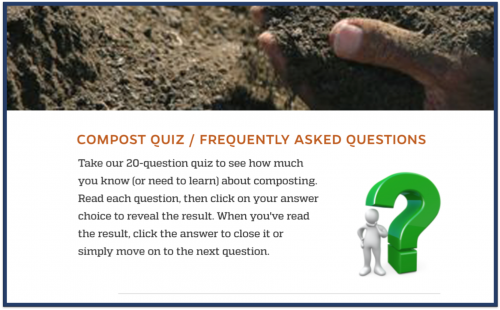 For this issue’s Action of the Month, I’m sharing my experience setting up an at-home compost system. Importantly, this article won’t teach you how to compost. For that, I’ll refer you to an incredible site put together by UF IFAS Extension. There you can learn how the compost process works, explore different compost set-ups, and even take a quiz to test your knowledge.
For this issue’s Action of the Month, I’m sharing my experience setting up an at-home compost system. Importantly, this article won’t teach you how to compost. For that, I’ll refer you to an incredible site put together by UF IFAS Extension. There you can learn how the compost process works, explore different compost set-ups, and even take a quiz to test your knowledge.
Instead, I will share how I got started composting and some of the lessons I’ve learned. Composting can be a part of almost anyone’s household, it’s just a matter of finding the right set-up—and being okay with some trial and error.
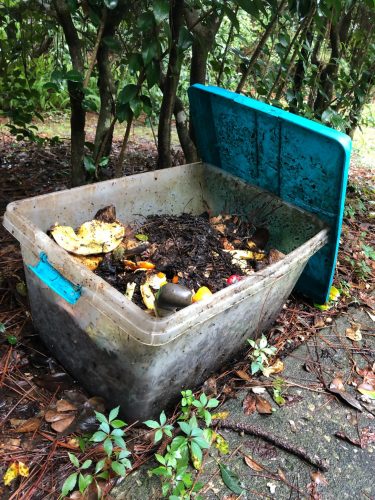 I started my current compost about two years ago, a few months after moving to Gainesville. I had a large, 20 gallon plastic tub that had cracked, so I decided to repurpose it as a self-contained compost bin. I drilled some holes in the bottom half of the bin to allow drainage and aeration, added some dry leaves I had raked up from my yard, and began contributing food scraps. It took less than an hour to get the entire thing set-up. In the beginning, I “turned” the compost by shaking the bin. Once the bin got too heavy, I switched to turning via trowel.
I started my current compost about two years ago, a few months after moving to Gainesville. I had a large, 20 gallon plastic tub that had cracked, so I decided to repurpose it as a self-contained compost bin. I drilled some holes in the bottom half of the bin to allow drainage and aeration, added some dry leaves I had raked up from my yard, and began contributing food scraps. It took less than an hour to get the entire thing set-up. In the beginning, I “turned” the compost by shaking the bin. Once the bin got too heavy, I switched to turning via trowel.
It is not a perfect set-up—but it works! At times my pile has been too wet and too compact, and I have never gotten to a professional-grade, garden-worthy compost-final product. But, using the compost bin has helped me keep food scraps out of the landfill and provided some nutritious dirt for my potted plants along the way. A victory in my book!
Beyond my original goal of keeping food scraps out of the landfill, here are some of the other benefits I’ve experienced by composting at home:
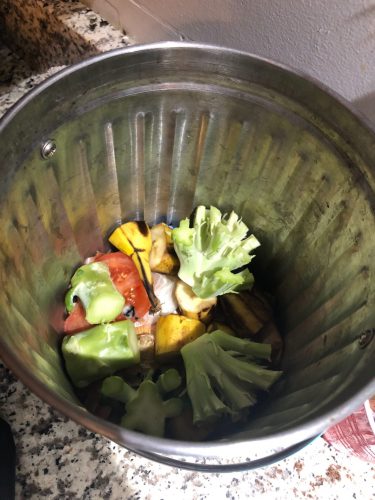 Keeping compostable food scraps out of the garbage bin has meant less trash to take out each week.
Keeping compostable food scraps out of the garbage bin has meant less trash to take out each week.
In the long run this has saved time, money, and resources spent on garbage bags. These personal benefits also translate to a greater good, in the form of less plastic entering the waste stream and less space being taken up in landfills.
Composting has changed my shopping habits.
Having to chop up and compost uneaten-but-spoiled produce has made me more aware of which items I overpurchase and am likely to waste. That feedback has helped me become a more accurate shopper, meaning I only purchase the produce I’m confident I can consume.
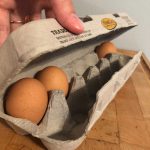 I’ve also learned to shop for items packaged in compostable materials, such as eggs packaged in cardboard. This has helped me add “brown” material to my compost to deal with some of my moisture issues and also keeps styrofoam and unrecyclable plastic out of the waste stream.
I’ve also learned to shop for items packaged in compostable materials, such as eggs packaged in cardboard. This has helped me add “brown” material to my compost to deal with some of my moisture issues and also keeps styrofoam and unrecyclable plastic out of the waste stream.
Additionally, composting has helped me switch to products that generate less waste overall. For example, I now use loose-leaf tea in a metal strainer rather than tea bags. The used leaves get dumped straight into my compost, and there is nothing further to throw away.
Finally, composting gets me outside.
Whether it’s dumping my food scraps or tending to the pile, composting adds to my “fresh air” time almost every day. New research continues to showcase the health benefits of spending time in nature, so I appreciate that composting requires me to spend some active time outside, even if it’s just a few minutes.
My composting journey is far from complete. My current set-up is reaching capacity and I’m hoping to harness the knowledge I’ve gained through the process to make my next compost even more successful.
Interested in giving composting a shot? Here are a few of the key things I’ve learned that might be useful for a curious new composter:
You do not need to purchase a fancy compost set-up to get started.
Because I already had the necessary materials on-hand, I spent $0 getting mine started. That being said, you can choose to invest in an inexpensive pre-made set-up if that’s what would work best for you. Choosing the compost set-up that matches your space and needs is essential; this UF IFAS page is a great place to explore many of the options.
Site your compost where you’ll actually use it.
Worrying about smell and animals, I had initially placed my compost bin as far away from my house as possible. Ultimately, this made me less likely to drop off food scraps and led to long periods of compost neglect. After I moved the compost bin closer, I found myself being much more attentive to its management.
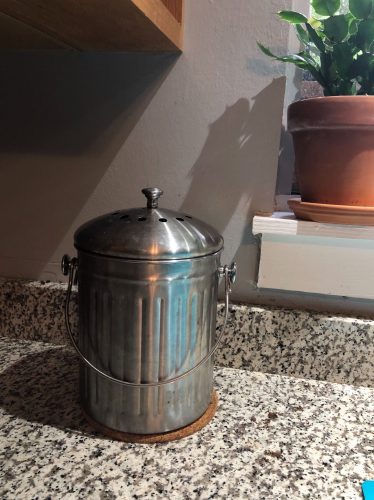 Have a food scrap collection bin in your kitchen.
Have a food scrap collection bin in your kitchen.
It can be hard to break the habit of tossing things into the trash. Before we had a dedicated compost collector bin, plenty of scraps continued to slip into the landfill waste stream. Having an obvious compost container on our counter has made all the difference, especially as it’s located near where we prep and chop produce anyway. One small warning—the countertop compost bin needs to be emptied often. It can get smelly and buggy quickly if left unattended too long!
Composting is just one of many strategies that can be used to cut down on food waste. Additional ways to reduce your food contributions to landfills include purchasing only what you think you will use and making a concerted effort to consume leftovers. You can learn more about the impacts of food waste and explore solutions here:
https://www.drawdown.org/solutions/food/reduced-food-waste
https://www.usda.gov/foodwaste/faqs
https://foodprints.earthday.org/food-waste/.
About the Author
 Sadie Mills is a coordinator and environmental educator for TESI. She manages programs and events that support TESI’s mission of educating Floridians about the state’s natural systems and the threats they face.
Sadie Mills is a coordinator and environmental educator for TESI. She manages programs and events that support TESI’s mission of educating Floridians about the state’s natural systems and the threats they face.